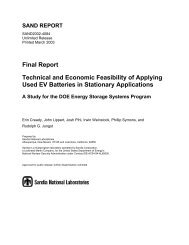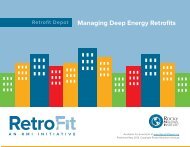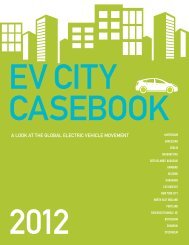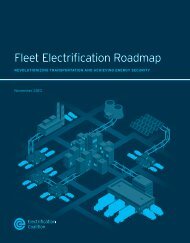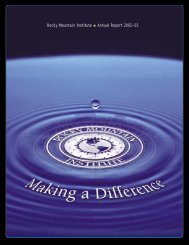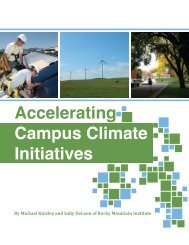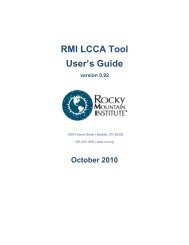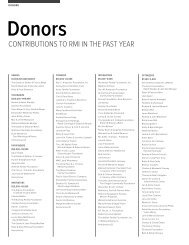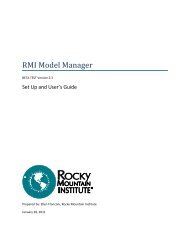Presentation: "Empire State Building Case Study" - The Empire State ...
Presentation: "Empire State Building Case Study" - The Empire State ...
Presentation: "Empire State Building Case Study" - The Empire State ...
You also want an ePaper? Increase the reach of your titles
YUMPU automatically turns print PDFs into web optimized ePapers that Google loves.
<strong>Empire</strong> <strong>State</strong> <strong>Building</strong> <strong>Case</strong> StudyCost-Effective Greenhouse Gas Reductions via Whole-<strong>Building</strong> Retrofits:Process, Outcomes, and What is Needed NextFor more information, please visit www.esbsustainability.comRocky Mountain Institute
OVERARCHING MESSAGE<strong>The</strong>re is a compelling need as well as an economic casefor reducing greenhouse gas emissions in existingbuildings. <strong>The</strong> <strong>Empire</strong> <strong>State</strong> <strong>Building</strong> case study providesan example of how this can be done. However, significantchallenges remain that must be addressed in order toquickly and cost-effectively capture the full greenhousegas reduction opportunity for building retrofits on awidespread basis.2
PRESENTATION OVERVIEWI. Motivation: <strong>The</strong> retrofit of the <strong>Empire</strong> <strong>State</strong> <strong>Building</strong> was motivated by the owners desire toreduce greenhouse gas emissions, to demonstrate how to retrofit large commercial buildings costeffectively, and to demonstrate that such work makes good business sense.II.III.Project Development Process: Using ESB as a convening point, a collaborativeteam was formed to develop the optimal retrofit solution through an iterative process that involvedexperience, energy and financial modeling, ratings, metrics, and robust debate.Key Findings: At current energy costs, ESB can cost-effectively reduce energy use by38% and save (a minimum of) 105,000 metric tons of CO2 over the next 15 years.IV. Implementation: Three different stakeholders will implement the 8 savings measures overa 5-year period using various implementation mechanisms.V. Key Lessons: Key lessons relate to strategies to maximize cost-effective savings,balancing CO2 savings with economics, and streamlining the project development process.VI. Industry Needs: Challenges in each stage of the retrofit process are hindering theachievement of long-term goals.3
I. MOTIVATION<strong>The</strong> retrofit of the <strong>Empire</strong> <strong>State</strong> <strong>Building</strong> was motivated by the buildingownership’s desire to:1) Prove or disprove the economic viability of whole-building energyefficiency retrofits.2) Create a replicable model for whole-building retrofits.3) Reduce greenhouse gas emissions.I. MotivationII. ProcessIII. Key FindingsIV. ImplementationV. Key LessonsVI. Needs
I. MOTIVATION1) Prove or disprove the economic viability of whole-building energy efficiencyretrofits.Prior to 2008, the <strong>Empire</strong> <strong>State</strong> <strong>Building</strong>’s performance was average comparedto most U.S. office buildings.Annual utility costs:• $11 million ($4/sq. ft.)Annual CO2 emissions:• 25,000 metric tons (22 lbs/sq. ft.)Annual energy use:• 88 kBtu/sq. ft.Peak electric demand:• 9.5 MW (3.8 W/sq. ft. inc. HVAC)5
I. MOTIVATION1) Prove or disprove the economic viability of whole-building energy efficiencyretrofits.Total ESB Capital Budget (million $)With a $500 million capital improvement program underway, ownershipdecided to re-evaluate certain projects with cost-effective energy efficiencyand sustainability opportunities in mind.120Capital Budget Adjustments for Energy Efficiency Projects100806040202008CapitalBudget forEnergy-RelatedProjects =$93m+ 0%EnergySavingsSum of adds /changes / deletes= +$13mNew CapitalBudget w /EfficiencyProjects =$106m+ 38% EnergySavings06
I. MOTIVATION1) Prove or disprove the economic viability of whole-building energy efficiencyretrofits.Nominal Dollars ($)Energy efficiency and sustainability provide amenities (lower energy costs,easier carbon reporting, daylighting, etc.) that set the building apart fromsurrounding tenant space.$15,000Illustrative: Tenant Utility Cash Flow$10,000$5,000$0($5,000)Year in Lease1 2 3 4 5 6 7 8 9 10 11 12($10,000)($15,000)($20,000)($25,000)($30,000)If tenants understand (and cancapture) the value of extrainvestments up front, they aremore likely to make them.Annual cost/savingsNPV7
I. MOTIVATION<strong>The</strong> retrofit of the <strong>Empire</strong> <strong>State</strong> <strong>Building</strong> was motivated by the buildingownership’s desire to:1) Prove or disprove the economic viability of whole-building energyefficiency retrofits.2) Create a replicable model for whole-building retrofits.3) Reduce greenhouse gas emissions.I. MotivationII. ProcessIII. Key FindingsIV. ImplementationV. Key LessonsVI. Needs
I. MOTIVATION2) Create a replicable model for whole-building retrofits.<strong>The</strong>re are known opportunities to cost-effectively reduce greenhouse gasemissions, yet few owners are pursuing them.Cutting U.S. Global Warming Pollution 80% by 2050: Cost & Payoff by Sector<strong>Building</strong> efficiency measures are identifiedas having negative costs.Source: NRDC - http://www.nrdc.org/globalwarming/blueprint/default.asp9
I. MOTIVATION2) Create a replicable model for whole-building retrofits.ESB ownership wants to demonstrate how to cost-effectively retrofit a largemulti-tenant office building to inspire others to embark on whole-buildingretrofits.810
I. MOTIVATION<strong>The</strong> retrofit of the <strong>Empire</strong> <strong>State</strong> <strong>Building</strong> was motivated by the buildingownership’s desire to:1) Prove or disprove the economic viability of whole-building energyefficiency retrofits.2) Create a replicable model for whole-building retrofits.3) Reduce greenhouse gas emissions cost-effectively.I. MotivationII. ProcessIII. Key FindingsIV. ImplementationV. Key LessonsVI. Needs
I. MOTIVATION3) Reduce Greenhouse Gas EmissionsWe need to reduce greenhouse gas emissions by 75% by 2050 to stabilizethe climate.85Business as usual global emissions*556276%Today, we’re at55 GtCO2e64%68%We need to be at20 GtCO2e by2050 to mitigateclimate change*Source: McKinsey Analysis, IPCC, Stern Review (2006)2008 2030 20501
Million Metric Tons of Carbon DioxideI. MOTIVATION3) Reduce Greenhouse Gas Emissions<strong>The</strong> building sector must be a large part of the solution as it is the largestcontributor to U.S. greenhouse gas emissions.2,500U.S. CO2 Emissions by End-Use Sector: 1980 - 20062,0001,5001,0005000<strong>Building</strong>s Industry Transportation<strong>Building</strong>s are responsible for 38%of CO2 emissionsWein theneedU.S.to be at20 GtCO2e by2050 to mitigateclimate change1980 1984 1988 1992 1996 2000 2004YearSource: EIA data - Table 12.2: http://www.eia.doe.gov/emeu/aer/envir.html1
Million square feet of Commercial <strong>Building</strong>I. MOTIVATION3) Reduce Greenhouse Gas EmissionsNearly 75% of U.S. commercial buildings are over 20 years old (and thusready for retrofit). Retrofitting existing buildings must be part of the solution.14,000U.S. Commercial <strong>Building</strong> Space by Age12,00010,00072% of the U.S. commercial stockwas constructed before 1990.8,0006,0004,0002,0000Before 1920 1920 to 1945 1946 to 1959 1960 to 1969 1970 to 1979 1980 to 1989 1990 to 1999 2000 to 2003Year ConstructedSource: EIA data - Table 12.2: http://www.eia.doe.gov/emeu/aer/envir.html1
I. MOTIVATION“<strong>The</strong> goal with ESB has been to define intelligent choices whichwill either save money, spend the same money more efficiently,or spend additional sums for which there is reasonable paybackthrough savings. Addressing these investments correctly willcreate a competitive advantage for ownership through lowercosts and better work environment for tenants. Succeeding inthese efforts will make a replicable model for others to follow.”- Anthony E. MalkinI. MotivationII. ProcessIII. Key FindingsIV. ImplementationV. Key LessonsVI. Needs
II. PROJECT DEVELOPMENT PROCESSUsing ESB as a convening point, a collaborative team was formed todevelop the optimal solution through a rigorous and iterative process thatinvolved experience, energy and financial modeling, ratings systems,technical advice, and robust debate. Key points include:1) Five key groups and a host of contributors used a collaborative anditerative approach.2) A 4-phase project development process helped guide progress.3) A variety of complementary tools were used and developed totriangulate to the best answer.I. MotivationII. ProcessIII. Key FindingsIV. ImplementationV. Key LessonsVI. Needs
II. PROJECT DEVELOPMENT PROCESS1) Five key groups and contributors used a collaborative and iterative approach.<strong>The</strong> project development process, which the team focused on, is the first steptowards executing and verifying the success of a retrofit.Retrofit Project Timeline2010 2025ProjectExecutionMeasurement &VerificationProject development is focused on understanding current performance, analyzingopportunities, and determining which projects to implement.17
II. PROJECT DEVELOPMENT PROCESS1) Five key groups and contributors used a collaborative and iterative approach.Core team members for the project development process included the ClintonClimate Initiative (CCI), Johnson Controls Inc. (JCI), Jones Lang LaSalle (JLL),Rocky Mountain Institute (RMI), and the <strong>Empire</strong> <strong>State</strong> <strong>Building</strong> (ESB).Team Organization ChartOwner<strong>Empire</strong> <strong>State</strong><strong>Building</strong> Company LLCProject AdvisorClinton Climate InitiativeProject ManagerJones Lang LaSalleOperationsReviewer<strong>Empire</strong> <strong>State</strong><strong>Building</strong> OperationsEnergy ServiceCompanyJohnson Controls Inc.Design Partner &Peer ReviewerRocky MountainInstitute18
II. PROJECT DEVELOPMENT PROCESS1) Five key groups and contributors used a collaborative and iterative approach.Many other contributors, in addition to the core team, provided additionalexpertise to fully explore all opportunities.Ownership/ManagementEngineersSustainabilityExpertsEnergyModelersContractorsBenchmarkingContractorEstimatesFieldVerificationEnergyModelingFinancial/LCCAModelingBrainstormingCharrettesToolDevelopmentProjectDevelopmentDesignDrawingsGoalSettingLeasing agents3 rd party reviewFinancialexpertsM&V expertsArchitects19
II. PROJECT DEVELOPMENT PROCESSUsing ESB as a convening point, a collaborative team was formed todevelop the optimal energy efficiency retrofit solution through a rigorous anditerative process that involved experience, energy and financial modeling,ratings systems, technical advice, and robust debate. Key points include:1) Five key groups and a host of contributors used a collaborative anditerative approach.2) A 4-phase project development process helped guide progress.3) A variety of complementary tools were used and developed totriangulate to the best answer.I. MotivationII. ProcessIII. Key FindingsIV. ImplementationV. Key LessonsVI. Needs
ActivitiesOutputsII. PROJECT DEVELOPMENT PROCESS2) A 4-phase project development process helped guide progress.Project activities (audits, workshops, presentations, analyses, reports, etc.)were divided into 4 phases.Phase I: Inventory& ProgrammingPhase II: DesignDevelopmentPhase III: DesignDocumentationPhase IV: FinalDocumentation• April 14 th kick-off meeting• May 7 th /May 14 th teamworkshops• June 2 nd <strong>Presentation</strong> toOwnership• June 18 th <strong>The</strong>oreticalMinimum workshop• July 2 nd workshop• July 15 th <strong>Presentation</strong> toownership• July 30 th Tenant Focusworkshop• August 13 th eQUESTworkshop• August 27 th <strong>Presentation</strong> toOwnership• Sept. 10 th workshop• Sept 29 th <strong>Presentation</strong> toOwnership• October 6-8 th Financeworkshop (Boulder)• Nov 10 th <strong>Presentation</strong> toOwnership• Baseline Capital ProjectsReport• Baseline EnergyBenchmark Report• Tenant Initiatives (prebuilts,design guidelines, energymanagement) Report• Tuned eQUEST model• Model (eQUEST, financial,GHG) outputs• Integrated SustainabilityMaster Plan Report (inc.Energy Master Plan)21
II. PROJECT DEVELOPMENT PROCESS2) A 4-phase project development process helped guide progress.Determining the optimal package of retrofit projects involved identifyingopportunities, modeling individual measures, and modeling packages of measures.IdentifyOpportunitiesModel IndividualMeasuresCreate Packagesof MeasuresModelIterativelyOutcome:Package of measures withbest economic &environmental benefits22
Absolute Metric Tons of CO2Dollars ($)II. PROJECT DEVELOPMENT PROCESS2) A 4-phase project development process helped guide progress.Significant time was spent 1) refining energy and financial model inputs to ensureoutputs were accurate and 2) understanding the critical relationship betweeneconomics and CO2 reductions.CO2 Emissions for eachPackageIncremental Cash Flow foreach Package of Measures2008 2010 2012 2014 2016 2018 2020 20222008 2010 2012 2014 2016 2018 2020 202223
II. PROJECT DEVELOPMENT PROCESSUsing ESB as a convening point, a collaborative team was formed todevelop the optimal solution through a rigorous and iterative process thatinvolved experience, energy and financial modeling, ratings systems,technical advice, and robust debate. Key points include:1) Five key groups and a host of contributors used a collaborative anditerative approach.2) A 4-phase project development process helped guide progress.3) A variety of complementary tools were used and developed totriangulate to the best answer.I. MotivationII. ProcessIII. Key FindingsIV. ImplementationV. Key LessonsVI. Needs
II. PROJECT DEVELOPMENT PROCESS3) A variety of tools were used and developed to triangulate to the best answer.Industry standard and newly developed design tools, decision-making tools,and rating tools helped to evaluate and benchmark existing and futureperformance.Design Tools Decision-Making Tools Rating Tools25
III. KEY FINDINGSAt current energy costs, the <strong>Empire</strong> <strong>State</strong> <strong>Building</strong> can cost-effectivelyreduce energy use by 38% and save (a minimum of) 105,000 metric tons ofCO2 over the next 15 years.1) Eight interactive levers ranging from base building measures totenant engagement deliver these results.2) Key reductions in peak cooling and electric loads are possible.3) Enhanced work environments are created.4) Various green certifications can be obtained.I. MotivationII. ProcessIII. Key FindingsIV. ImplementationV. Key LessonsVI. Needs
Net Present Value of Package of MeasuresThousandsIII. KEY FINDINGS1) Eight interactive levers ranging from base building measures to tenantengagement deliver these results.<strong>The</strong> <strong>Empire</strong> <strong>State</strong> <strong>Building</strong> can achieve a high level of energy and CO2reduction cost-effectively.15-Year NPV of Package versus Cumulative CO2 Savings$35,000$15,000NPV “Max”<strong>The</strong>re are diminishing (andexpensive) returns forgreater efficiency.NPV “Mid”A solution thatbalances CO2reductions andfinancial returns isin this range.NPV “Neutral”($5,000)0 40,000 80,000 120,000 160,000Cumulative metric tons of CO2 saved over 15 years“Max CO2”Reduction($25,000)27
Cost per Metric Ton of CO2III. KEY FINDINGS1) Eight interactive levers ranging from base building measures to tenantengagement deliver these results.Achieving an energy reduction greater than 38% appears to be cost-prohibitive.$4,000$2,000Cost per Metric Ton of CO2 by Individual Measure<strong>The</strong> average cost per ton of carbon dioxide saved forthe first 90% of the savings is -$200/ton while theaverage cost per ton for the last 10% is over $300per ton.$0($2,000)28
III. KEY FINDINGS1) Eight interactive levers ranging from base building measures to tenantengagement deliver these results.Energy and CO2 savings in the optimal package result from 8 key projects.Annual Energy Use (kBtu)Thousands300,000200,000100,0009%Annual Energy Savings by Measure6%5%5%5%3% 3% 2%38%Reduction029
III. KEY FINDINGS1) Eight interactive levers ranging from base building measures to tenantengagement deliver these results.Taking the right steps in the right order ensures loads are minimized prior toinvestigating expensive new equipment or controls.Reduce LoadsUse Efficient TechnologyProvide Controls30
III. KEY FINDINGS1) Eight interactive levers ranging from base building measures to tenantengagement deliver these results.WINDOWS: Remanufacture existing insulated glass units (IGU) within the<strong>Empire</strong> <strong>State</strong> <strong>Building</strong>’s approximately 6,500 double-hung windows to includesuspended coated film and gas fill.31
III. KEY FINDINGS1) Eight interactive levers ranging from base building measures to tenantengagement deliver these results.RADIATIVE BARRIER: Install more than six-thousand insulated reflectivebarriers behind radiator units located on the perimeter of the building.32
III. KEY FINDINGS1) Eight interactive levers ranging from base building measures to tenantengagement deliver these results.TENANT DAYLIGHTING / LIGHTING / PLUGS: This measure involvesreducing lighting power density in tenant spaces, installing dimmable ballastsand photosensors for perimeter spaces, and providing occupants with a plugload occupancy sensor for their personal workstation.33
III. KEY FINDINGS1) Eight interactive levers ranging from base building measures to tenantengagement deliver these results.CHILLER PLANT RETROFIT: <strong>The</strong> chiller plant retrofit project includes theretrofit of four industrial electric chillers in addition to upgrades to controls,variable speed drives, and primary loop bypasses.34
III. KEY FINDINGS1) Eight interactive levers ranging from base building measures to tenantengagement deliver these results.VAV AIR HANDLING UNITS: Replace existing constant volume units withvariable air volume units using a new air handling layout (two floor-mountedunits per floor instead of four ceiling-hung units).35
III. KEY FINDINGS1) Eight interactive levers ranging from base building measures to tenantengagement deliver these results.DDC CONTROLS: <strong>The</strong> measure involves upgrading the existing controlsystems at the <strong>Empire</strong> <strong>State</strong> <strong>Building</strong>.36
III. KEY FINDINGS1) Eight interactive levers ranging from base building measures to tenantengagement deliver these results.DEMAND CONTROL VENTILATION: This project involves the installation ofCO2 sensors for control of outside air introduction to chiller water and DX AirHandling Units.37
III. KEY FINDINGS1) Eight interactive levers ranging from base building measures to tenantengagement deliver these results.TENANT ENERGY MANAGEMENT: This project will provide tenants withaccess to online energy and benchmarking information as well as sustainabilitytips and updates.38
III. KEY FINDINGS1) Eight interactive levers ranging from base building measures to tenantengagement deliver these results.Though it is more informative to look at financials for the package of measures,capital costs and energy savings were determined for each individual measure.ProjectDescriptionProjectedCapital Cost2008 CapitalBudgetIncrementalCostEstimatedAnnualEnergy Savings*Windows $4.5m $455k $4m $410kRadiative Barrier $2.7m $0 $2.7m $190kDDC Controls $7.6m $2m $5.6m $741kDemand Control Vent Inc. above $0 Inc. above $117kChiller Plant Retrofit $5.1m $22.4m -$17.3m $675kVAV AHUs $47.2m $44.8m $2.4m $702kTenant Day/Lighting/Plugs $24.5m $16.1m $8.4m $941kTenant Energy Mgmt. $365k $0 $365k $396kPower Generation (optional) $15m $7.8m $7m $320kTOTAL (ex. Power Gen) $106.9m $93.7m $13.2m $4.4m*Note that energy savings are also incremental to the original capital budget.39
III. KEY FINDINGSAt current energy costs, the <strong>Empire</strong> <strong>State</strong> <strong>Building</strong> can cost-effectivelyreduce energy use by 38% and save (a minimum of) 105,000 metric tons ofCO2 over the next 15 years.1) Eight interactive levers ranging from base building measures totenant engagement deliver these results.2) Key reductions in peak cooling and electric loads are expected.3) Enhanced work environments are created.4) Various green certifications can be obtained.I. MotivationII. ProcessIII. Key FindingsIV. ImplementationV. Key LessonsVI. Needs
III. KEY FINDINGS2) Key reductions in peak cooling and electric loads are expected.<strong>The</strong> selected package of measures reduces peak cooling requirements by 33%(1600 tons) enabling immediate and future CapEx avoidance.Net Present Value ($) Thousands40,00030,00020,00010,0000-10,000-20,000NPV Max PackageCost of Cooling Efficiency<strong>The</strong> 1600-ton load reduction allows forthe chiller retrofit instead ofreplacement/adding capacity.NPV Mid PackageNPV NeutralPackage0 200 400 600 800 1,000 1,200 1,400 1,600 1,800 2,000Reduction in Peak Cooling CapacityCO2 Max Package41
Office <strong>Building</strong> Peak Demand (MW)III. KEY FINDINGS2) Key reductions in peak cooling and electric loads are expected.<strong>The</strong> optimal package of measures also reduces peak electrical demand by 3.5MW, benefitting both the building and the utility.12Office <strong>Building</strong> Electrical Capacity108If on-site back-up generation is desired,options include:642CurrentPeakCapacityFuturePeakCapacity• Cogeneration;• Gas-fired/bio-fuel fired generation;• Fuel cells;• Renewables (PV/wind); and• Purchasing new capacity from ConEdison042
III. KEY FINDINGSAt current energy costs, the <strong>Empire</strong> <strong>State</strong> <strong>Building</strong> can cost-effectivelyreduce energy use by 38% and save (a minimum of) 105,000 metric tons ofCO2 over the next 15 years.1) Eight interactive levers ranging from base building measures totenant engagement deliver these results.2) Key reductions in peak cooling and electric loads are expected.3) Enhanced work environments are created.4) Various green certifications can be obtained.I. MotivationII. ProcessIII. Key FindingsIV. ImplementationV. Key LessonsVI. Needs
III. KEY FINDINGS3) Enhanced work environments are created.This package of measures also results in enhanced indoor environmentalquality and additional amenities for tenants:• Better thermal comfort resulting from better windows, radiativebarrier, and better controls;• Improved indoor air quality resulting from DCV; and• Better lighting conditions that coordinateambient and task lighting.44
III. KEY FINDINGSAt current energy costs, the <strong>Empire</strong> <strong>State</strong> <strong>Building</strong> can cost-effectivelyreduce energy use by 38% and save (a minimum of) 105,000 metric tons ofCO2 over the next 15 years.1) Eight interactive levers ranging from base building measures totenant engagement deliver these results.2) Key reductions in peak cooling and electric loads are expected.3) Enhanced work environments are created.4) Various green certifications can be obtained.I. MotivationII. ProcessIII. Key FindingsIV. ImplementationV. Key LessonsVI. Needs
III. KEY FINDINGS4) Various green certifications can be achieved.This recommended package of measures helps to earn 12 LEED EBOMpoints, an Energy Star score of 90, and a 72% Green Globes score.PackageEnergySavings*Energy StarLEEDPointsGreenGlobesNPV Max 20% 82 8 64%NPV Mid 38% 90 12 72%NPV Neutral 45% 91 13 76%CO2 Max 48% 92 13 78%46
III. KEY FINDINGS4) Various green certifications can be achieved.<strong>The</strong> <strong>Empire</strong> <strong>State</strong> <strong>Building</strong> will be pursuing the Energy Star label as well asGold certification under the LEED for Existing <strong>Building</strong>s: Operation &Maintenance Rating System.47
IV. IMPLEMENTATIONClear energy targets and responsible parties must be determined for each ofthe 8 major savings measures to fully maximize the environmental andeconomic benefits.1) Three stakeholders, with different implementation mechanisms, willdeliver the savings.2) <strong>The</strong> project will be financed out of cash flow, though other financingopportunities are being investigated.3) Work has already started and will be complete by 2013 (55% of thesavings will be in place by December 31, 2010).I. MotivationII. ProcessIII. Key FindingsIV. ImplementationV. Key LessonsVI. Needs
Annual Energy Savings (kBtu)IV. IMPLEMENTATION1) Three stakeholders, with different implementation mechanisms, will deliverthe savings.Johnson Controls, the <strong>Empire</strong> <strong>State</strong> <strong>Building</strong>, and Tenants are eachresponsible for delivering some of the total savings.250,000,000Energy Savings by Implementation Stakeholder200,000,00061%150,000,00022%17%100,000,00050,000,0000Adjusted Baseline JCI ESB Tenant NPV Mid49
IV. IMPLEMENTATION1) Three stakeholders, with different implementation mechanisms, will deliverthe savings.Who implements each project?Project DescriptionImplementerWindowsRadiative BarrierDDC ControlsDemand Control VentChiller Plant RetrofitVAV AHUsTenant Day/Lighting/PlugsTenant Energy Mgmt.Johnson ControlsJohnson ControlsJohnson ControlsJohnson ControlsJohnson Controls<strong>Empire</strong> <strong>State</strong> <strong>Building</strong>Tenants & <strong>Empire</strong> <strong>State</strong> <strong>Building</strong>All50
IV. IMPLEMENTATION1) Three stakeholders, with different implementation mechanisms, will deliverthe savings.Johnson Controls Inc will deliver 61% of the total savings using a performancecontract mechanism. Five different performance contracts have a total cost of$20 million and guaranteed savings of ~20% percent.How does the Performance Contract work?1. ESB pays JCI guaranteed maximum price for capital cost of allprojects2. ESB accrues energy savings as a result of theretrofit projects … if savings are too low,ESB/TenantsJCI pays ESB the difference.17%3. Savings guarantee term is 15 years JCIESB22%61%51
IV. IMPLEMENTATION1) Three stakeholders, with different implementation mechanisms, will deliverthe savings.<strong>Empire</strong> <strong>State</strong> <strong>Building</strong> will deliver 22% of the total available savings as airhandling units and pre-built spaces are replaced over the next 4 years.ESB/Tenants17%ESB22%JCI61%52
IV. IMPLEMENTATION1) Three stakeholders, with different implementation mechanisms, will deliverthe savings.ESB is responsible for helping/incentivizing tenants to pay for and achievenearly 20% of the total available energy savings as spaces turnover.ESB/Tenants17%ESB22%JCI61%53
IV. IMPLEMENTATION1) Three stakeholders, with different implementation mechanisms, will deliverthe savings.<strong>The</strong> team has identified 3 programs that will help to reduce and manage tenantenergy use:1. Tenant pre-built program: <strong>The</strong> proposed green pre-built design will save $0.70- $0.90/sq. ft. in operating costs annually for an additional cost of $6/sq. ft. andhelp ESB demonstrate design principles for all tenants to endorse.2. Tenant design guidelines: Design guidelines, based on the pre-built program,will provide green ESB standards. Tenants can verify the economic validity of therecommendations by accessing the eQUEST model or tenant financial tool.3. Tenant energy management program: ESB will begin sub-metering all tenantspaces and manage a feedback/reporting tool to inform tenants about theirenergy use. This program will also assist tenants with their own carbon reportingefforts.54
IV. IMPLEMENTATIONClear energy targets and responsible parties must be determined for each ofthe 8 major savings measures to fully maximize the environmental andeconomic benefits.1) Three stakeholders, with different implementation mechanisms, willdeliver the savings.2) <strong>The</strong> project will be financed out of cash flow, though other financingopportunities are being investigated.3) Work has already started and will be complete by 2013 (55% of thesavings will be in place by December 31, 2010).I. MotivationII. ProcessIII. Key FindingsIV. ImplementationV. Key LessonsVI. Needs
Total ESB Capital Budget (million $)IV. IMPLEMENTATION2) <strong>The</strong> project will be financed out of cash flow, though other financingopportunities are being investigated.<strong>The</strong> additional $13.2 million required for energy efficiency projects will be paidfor out of cash flow.120Capital Budget Adjustments for Energy Efficiency Projects100806040202008CapitalBudget forEnergy-RelatedProjects =$93m+ 0%EnergySavingsSum of adds /changes / deletes= +$13mNew CapitalBudget w /EfficiencyProjects =$106m+ 38% EnergySavings056
IV. IMPLEMENTATIONClear energy targets and responsible parties must be determined for each ofthe 8 major savings measures to fully maximize the environmental andeconomic benefits.1) Three stakeholders, with different implementation mechanisms, willdeliver the savings.2) <strong>The</strong> project will be financed out of cash flow, though other financingopportunities are being investigated.3) Work has already started and will be complete by 2013 (55% of thesavings will be in place by December 31, 2010).I. MotivationII. ProcessIII. Key FindingsIV. ImplementationV. Key LessonsVI. Needs
IV. IMPLEMENTATION3) Work has already started and will be complete by 2013.<strong>The</strong> projects to be implemented via the Johnson Controls performance contractwill be complete by October 2010. <strong>The</strong> remaining projects will be complete byDecember 2013.April2009October2010December2013Finalengineering &subcontractorawardsChiller Plant RetrofitDDC ControlsDemand Control VentilationWindowsRadiatorsAHU replacementTenant Energy ManagementTenant Lighting, Daylighting, Plugs58
V. LESSONS LEARNEDKey lessons learned for the retrofit of large commercial office buildingsinclude:1) <strong>The</strong> maximum cost-effective savings are achieved by:a) Taking a whole-systems, dynamic, life-cycle approach;b) Coordinating projects with equipment replacement cycles; andc) Addressing tenant spaces.2) At a certain point, there is tension between CO2 savings andbusiness value (even with anticipated CO2 regulations).3) <strong>The</strong> process can and must be streamlined.I. MotivationII. ProcessIII. Key FindingsIV. ImplementationV. Key LessonsVI. Needs
V. LESSONS LEARNED1) Several approaches help maximize cost-effective savings.A. Teams must take a whole-systems, dynamic, life-cycle approach.Reduce LoadsCapital CostUtility SavingsUtility RebatesUse EfficientTechnologyTax ImplicationsO&M ImpactsEscalation AssumptionsDiscount RateProvide ControlsFuture Cost of CO2Tenant Utility Structure60
Net Present Value of Package of MeasuresV. LESSONS LEARNED1) Several approaches help maximize cost-effective savings.B. Projects are most cost-effective when coordinated with equipmentreplacement cycles.$40,000,000$20,000,00015-Year NPV of Package versus Cumulative CO2 SavingsIncrementalCapEx$0($20,000,000)0 20,000 40,000 60,000 80,000 100,000 120,000 140,000 160,000($40,000,000)($60,000,000)AbsoluteCapEx($80,000,000)($100,000,000)Cumulative metric tons of CO2 saved over 15 years61
Annual Energy Savings (kBtu)V. LESSONS LEARNED1) Several approaches help maximize cost-effective savings.C. More than half the savings exist within tenant spaces – don’t ignore them!60,000,000Energy Savings: Base <strong>Building</strong> vs. within Tenant Space50,000,00040,000,000Tenant DCVRadiative BarrierTenant EnergyManagement30,000,00020,000,000Retrofit ChillerBldg WindowsVAV AHU's10,000,0000Balance of DDCMeasures that only affect the Base <strong>Building</strong>Tenant Daylighting/Lighting/PlugsMeasures within Tenant Space62
V. LESSONS LEARNEDKey lessons learned for the retrofit of large commercial office buildingsinclude:1) <strong>The</strong> maximum cost-effective savings are achieved by:a) Taking a whole-systems, dynamic, life-cycle approach;b) Coordinating projects with equipment replacement cycles; andc) Addressing tenant spaces.2) At a certain point, there is tension between CO2 savings andbusiness value (even with anticipated CO2 regulations).3) <strong>The</strong> process can and must be streamlined.I. MotivationII. ProcessIII. Key FindingsIV. ImplementationV. Key LessonsVI. Needs
Annual Energy Cost in DollarsV. LESSONS LEARNED2) At a certain point, there is tension between CO2 savings and business value.Maximizing business value leaves considerable CO2 on the table.Energy Cost Savings by Package250,000,000200,000,00020%19%Choice package tomaximize NPV.150,000,000100,000,0007%3%50,000,0000Adjusted Baseline NPV Max NPV Mid NPV Neutral CO2 Max Year 1564
Net Present Value of Package of MeasuresV. LESSONS LEARNED2) At a certain point, there is tension between CO2 savings and business value.Attempting to save CO2 faster may be cost prohibitive.$40,000,00015-Year NPV of Package versus Cumulative CO2 Savings$30,000,000$20,000,000$10,000,000$0($10,000,000)Acceleration reduces theNPV as projects becomeout of sync withreplacement cyclesNPV MidNPV MidAcclerated0 20,000 40,000 60,000 80,000 100,000 120,000 140,000 160,000($20,000,000)($30,000,000)($40,000,000)Cumulative metric tons of CO2 saved over 15 years65
NPV ($)V. LESSONS LEARNED2) At a certain point, there is tension between CO2 savings and business value.Anticipated CO2 regulation in the U.S. doesn’t change the solution set …though European levels of regulation would.$50,000,000$40,000,000$30,000,000$20,000,00015-Yr NPV and Cumulative CO2 Savings at Fluctuating Carbon Costs$10,000,000$0($10,000,000)0 20,000 40,000 60,000 80,000 100,000 120,000 140,000 160,000($20,000,000)($30,000,000)Cumulative CO2 Savings (Metric Tons)No Regulation.33% CA: Low Carbon Economy Act1.34%: RGGI 2% CA: Lieberman Warner8.8% CA: EU OTC66
V. LESSONS LEARNEDKey lessons learned for the retrofit of large commercial office buildingsinclude:1) <strong>The</strong> maximum cost-effective savings are achieved by:a) Taking a whole-systems, dynamic, life-cycle approach;b) Coordinating projects with equipment replacement cycles; andc) Addressing tenant spaces.2) At a certain point, there is tension between CO2 savings andbusiness value (even with anticipated CO2 regulations).3) <strong>The</strong> process can and must be streamlined.I. MotivationII. ProcessIII. Key FindingsIV. ImplementationV. Key LessonsVI. Needs
Time and CostsV. LESSONS LEARNED3) <strong>The</strong> process can and must be streamlined.Several opportunities to reduce the time and cost of the project developmentprocess exist.Opportunities to Improve Project Development ProcessReduction intime and costs?Project DevelopmentTimeImproved Process Apply Insights Improved Tools Optimized ProjectDevelopment Time68
VI. INDUSTRY NEEDSThis project was a great “test lab”, but what now? If all buildings need to beretrofitted to profitably reduce greenhouse gas emissions by 75% by 2050,we have a lot of work to do in a short amount of time.Outcome: 75% Reduction by 2050Opportunity Areas: Residential, Commercial, IndustrialBarriers: What is preventing us from reaching our goal?Strategies: What is the most impactful way to overcome barriers?Coordination: Who is working on what and what can you do?I. MotivationII. ProcessIII. Key FindingsIV. ImplementationV. Key LessonsVI. Needs
VI. INDUSTRY NEEDSBarriers exist in each phase of the retrofit process. Below are the major barriersthis team believes are paramount to overcome in order to reach our 2050 goal.ProjectOriginProjectDevelopmentRetrofit Project PhasesFinancing& Construction &Contracting CommissioningMeasurement& Verificationa. Selecting theright buildingsfor wholesystemsretrofitsb. Developingsolutions forall buildingtypesc. Projectdevelopmentanalysis toolsc. Policye. Engineeringcapacityf. Cost ofmeasuresg. Financing(base buildingand tenant)h. Performancebaseddesignandconstructioncontracts• TBD• TBD70
VI. INDUSTRY NEEDSa) Select the right buildings for whole-systems retrofitsRetrofitting the right buildings in the right order can reduce the societal cost($/metric ton) for carbon abatement.431271
VI. INDUSTRY NEEDSb) Develop solutions for small to mid-range commercial buildings.Most retrofit or energy service companies only address large commercialbuildings or residential buildings. Yet 95% of the U.S. building stock is small tomid-sized buildings that consume 44% of total energy use.Source: EIA data72
VI. INDUSTRY NEEDSc) Develop better project development tools.Significant time was spent creating the energy and financial models for thisbuilding and then iterating between them. Quicker and simpler tools could helpaccelerate the process.73
VI. INDUSTRY NEEDSd) Use policy and regulation to incentivize deeper savings and to make theprocess cheaper and more transparent.Federal stimulus money, city or state mandated retrofits, and more shared dataon opportunities and performance will make retrofits faster and cheaper.MAYOR BLOOMBERGAND SPEAKER QUINNANNOUNCE MAJORPACKAGE OFLEGISLATION TOCREATE GREENER,GREATER BUILDINGSPLAN FOR NEW YORKCITYSource: Recovery.gov74
VI. INDUSTRY NEEDSe) Increase workforce capacity of whole-systems trained auditors, engineers,operators, and commissioning agents.<strong>The</strong>re is a lack of American engineers who are trained and ready to rebuildefficient buildings, cities, and cars.Science &Engineering“<strong>The</strong>re is no negawatt university” – Amory LovinsSource: RAND Issue paper - http://www.rand.org/pubs/issue_papers/IP241/IP241.pdf75
VI. INDUSTRY NEEDSf) Determine how to make efficiency measures and renewable energytechnologies more cost-effective.Value-chain analyses can help determine opportunities for cost reductions fortechnologies that can save significant amounts of energy.• Additional controls;• Easy to install methods to retrofit exterior wall systems to increase thermalresistance;• LED lighting;• DALI lighting controls;• Chilled beam systems;• Heat recovery systems;• Green roofs;• Rainwater collection;• Condenser water savings;• Dessicant systems; and• Even higher performance windows.76
VI. INDUSTRY NEEDSg) Determine solutions for both base building and tenant financing.Availability of capital is a major hurdle and a variety of innovative solutions thatwork for large, small, owner-occupied, and leased spaces is needed.77
VI. INDUSTRY NEEDSh) Standardize (and use) performance-based design and construction contracts.Design and engineering parties are often incentivized by different outcomes,thus deterring the group from optimizing energy efficiency.Get paid for what you save, not what you spend.78
CONCLUSION<strong>The</strong>re is a compelling need as well as an economic casefor reducing greenhouse gas emissions in existingbuildings. <strong>The</strong> <strong>Empire</strong> <strong>State</strong> <strong>Building</strong> case study providesan example of how this can be done. However, significantchallenges remain that must be addressed in order toquickly and cost-effectively capture the full greenhousegas reduction opportunity for building retrofits on awidespread basis.I. MotivationII. ProcessIII. Key FindingsIV. ImplementationV. Key LessonsVI. Needs
For more information, please contact:Iain CampbellJohnson Controls, Inc.VP & GM, NA Solutions, <strong>Building</strong> Efficiency+1 414 524 7701iain.a.campbell@jci.comKathy BaczkoClinton Climate InitiativeNew York City Director+1 646 981 6472kbaczko@clintonfoundation.orgRay QuartararoJones Lang LaSalleRocky Mountain Rocky Mountain InstituteNortheast Regional Manager, International Director+1 212 812 5857Ray.quartararo@am.jll.comAmory LovinsChief Scientist+1 970 927 3851ablovins@rmi.orgAnthony E. Malkin<strong>Empire</strong> <strong>State</strong> <strong>Building</strong>OwnerMore project information available at:www.esbsustainability.com



